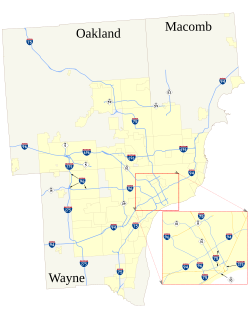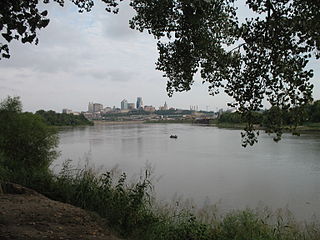
Huron County is a county in the U.S. state of Michigan. As of the 2010 United States Census, the population was 33,118. The county seat is Bad Axe.
Huron County is at the northern tip of the Thumb, which is a sub region of Mid Michigan. It is a peninsula, bordered by Saginaw Bay to the west and Lake Huron to the north and east, and has over 90 miles (140 km) of shoreline, from White Rock on Lake Huron to Sebewaing on the Saginaw Bay. Huron County's most important industry is agriculture, as with most of the other Thumb counties. Huron County enjoys seasonal tourism from large cities such as Detroit, Flint, and Saginaw.

Johnson County is a county located in the U.S. state of Kansas. Largely suburban, its proximity to Kansas City, Missouri has led to population growth within the Kansas City Metropolitan Area. As of the 2010 census, the county population was 544,179, making it the most populous county in Kansas. Its county seat is Olathe, and its most populous city is Overland Park.

Edwardsville is a city in Wyandotte County, Kansas, United States and is part of the "Unified Government" which also contains Kansas City, Kansas, most of Bonner Springs, and roughly one quarter of Lake Quivira. As of the 2010 census, the city population was 4,340.

Kansas City is the third-largest city in the State of Kansas, the county seat of Wyandotte County, and the third-largest city of the Kansas City metropolitan area. Kansas City, Kansas is abbreviated as "KCK" to differentiate it from Kansas City, Missouri, after which it is named. It is part of a consolidated city-county government known as the "Unified Government". Wyandotte County also includes the independent cities of Bonner Springs and Edwardsville. As of the 2010 census, the city had a population of 145,786 residents. It is situated at Kaw Point, which is the junction of the Missouri and Kansas rivers.

The Wyandot people or Wendat, also called the Huron Nation and Huron people, are an Iroquoian-speaking peoples of North America who emerged as a tribe around the north shore of Lake Ontario. They traditionally spoke the Wyandot language, a Northern Iroquoian language, and were believed to number over 30,000 at the time of European encounter in the second decade of the 17th century.

Bonner Springs is a city in Wyandotte, Leavenworth, and Johnson counties, Kansas, United States. It is part of the Kansas City Metropolitan Area. As of the 2010 census, the city population was 7,314, and in 2016 the estimated population was 7,665. Bonner Springs was incorporated as a city on November 10, 1898. Bonner Springs is home to the Providence Medical Center Amphitheater, the National Agricultural Center and Hall of Fame, and the annual Kansas City Renaissance Festival.

The Kansas City metropolitan area is a 14 county metropolitan area anchored by Kansas City, Missouri, and straddling the border between the U.S. states of Missouri and Kansas. With a population of 2,104,509, it ranks as the second largest metropolitan area centered in Missouri. Alongside Kansas City, the area includes a number of other cities and suburbs, the largest being Overland Park, Kansas; Kansas City, Kansas; Olathe, Kansas; and Independence, Missouri; each over 100,000 in population. The Mid-America Regional Council (MARC) serves as the Council of Governments and the Metropolitan Planning Organization for the area.

The Thumb is a region and a peninsula of the U.S. state of Michigan, so named because the Lower Peninsula is shaped like a mitten. The Thumb area is generally considered to be in the Central Michigan region, located east of the Tri-Cities, and north of Metro Detroit. The region is also branded as the Blue Water Area of Michigan.

Wendake is the current name for an urban reserve of the Huron-Wendat Nation in the Canadian province of Quebec. It is an enclave entirely surrounded by the La Haute-Saint-Charles borough of Quebec City, within the former city of Loretteville. One of the Seven Nations of Canada, the settlement was formerly known as Village-des-Hurons, and also as (Jeune)-Lorette.

The Wyandotte Nation is a federally recognized Native American tribe in Oklahoma. They are descendants of the Wendat Confederacy and Native Americans with territory near Georgian Bay and Lake Huron. Under pressure from Iroquois and other tribes, then from European settlers and the United States government, the tribe gradually moved south and west to Ohio, Michigan, Kansas and finally Oklahoma in the United States.

This is a list of official neighborhoods in Louisville, Kentucky. Like many older American cities, Louisville has well-defined neighborhoods, many with well over a century of history as a neighborhood.

Eliza Burton "Lyda" Conley was an Wyandot-American lawyer of Native American and European descent, the first woman admitted to the Kansas bar. She was notable for her campaign to prevent the sale and development of the Huron Cemetery in Kansas City, now known as the Wyandot National Burying Ground. She challenged the government in court, and in 1909 she was the first Native American woman admitted to argue a case before the Supreme Court of the United States.
K-32 is an approximately 35-mile (56 km) state highway that runs from Lawrence to Kansas City in the U.S. state of Kansas, generally paralleling the course of the Kansas River. Its western terminus is just outside Lawrence at US-24/US-40. Its eastern terminus is in Kansas City at US-69.

The Sanilac Shores Underwater Preserve was established to promote conservation of the submerged historical resources in Lake Huron near Port Sanilac, Michigan. The Sanilac Shores Underwater Preserve spans a total of 163 square miles (420 km2) of Lake Huron. The Michigan Underwater Preserve Council oversees activities relating to all of Michigan's Underwater Preserves.

The roads and freeways in metropolitan Detroit comprise the main thoroughfares in the region. The freeways consist of an advanced network of interconnecting freeways which include Interstate highways. The Metro Detroit region's extensive toll-free freeway system, together with its status as a major port city, provide advantages to its location as a global business center. There are no toll roads in Michigan.


















